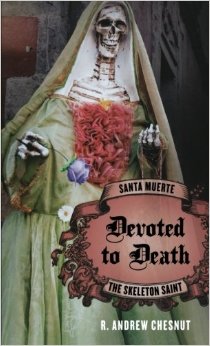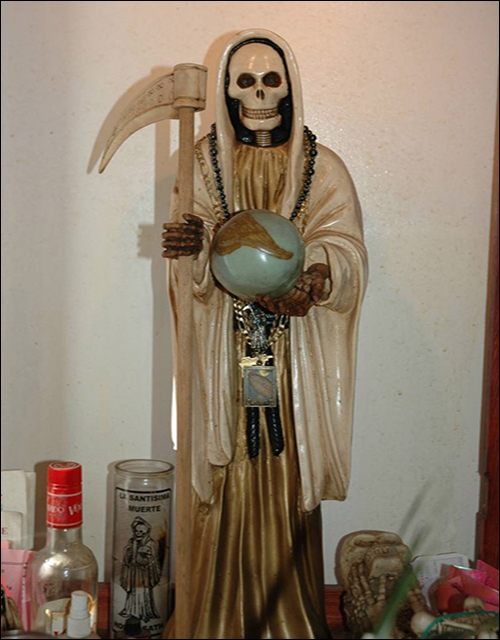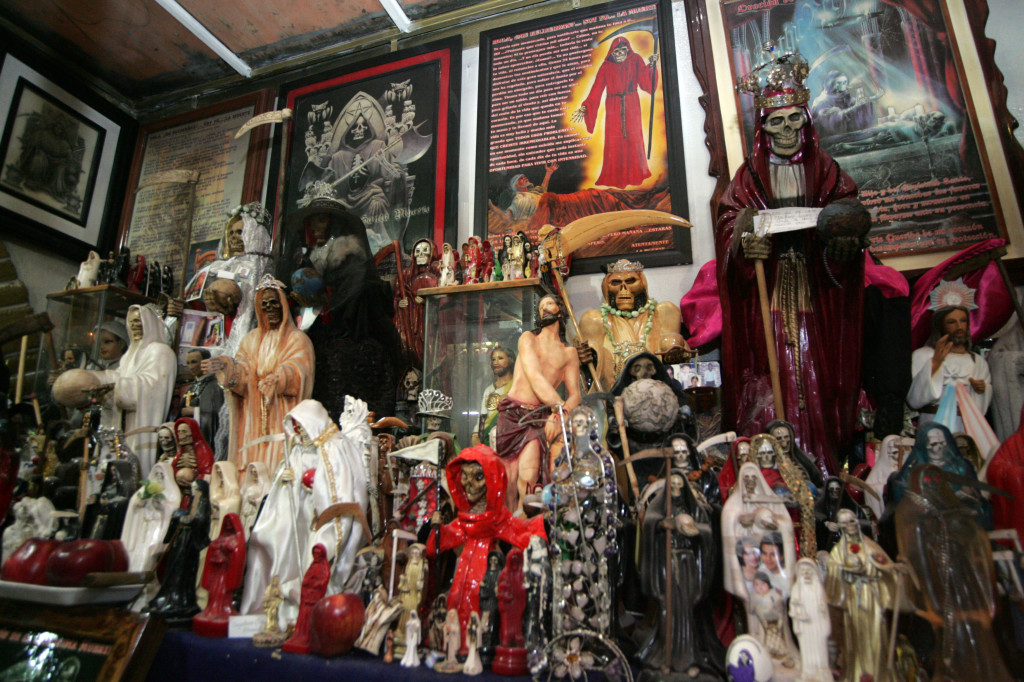 R. Andrew Chesnut is Professor of Religious Studies, Virginia Commonwealth University. He is the author of Devoted to Death: Santa Muerte, the Skeleton Saint (Oxford University Press, 2012), the first academic study of this topic in in English. He is currently working on the sequel. Chesnut discusses Santa Muerte in the interview below.
R. Andrew Chesnut is Professor of Religious Studies, Virginia Commonwealth University. He is the author of Devoted to Death: Santa Muerte, the Skeleton Saint (Oxford University Press, 2012), the first academic study of this topic in in English. He is currently working on the sequel. Chesnut discusses Santa Muerte in the interview below.
TheoFantastique: Thank you for coming here to discuss your research in this interesting topic. How did you come to develop a research interest in Santa Muerte?
Andrew Chesnut: I’m a specialist in the religions of Latin America and was working on my third book project, a study of the Virgin of Guadalupe, when in March, 2009 I saw that Mexican president Felipe Calderon sent the the army to demolish some forty Santa Muerte shrines on the border with Texas and California. I already knew of the Bony Lady from previous research and thirty years of living and traveling in Mexico but was intrigued that she had become spiritual enemy number one in the Mexican government’s war against the drug cartels.
TheoFantastique: What are the cultural and religious origins and influences in Santa Muerte?
Andrew Chesnut: She is a syncretic Mexican folk saint who integrates both Spanish Catholic and PreColumbian religious influences. The Spanish Church brought the figure of the Grim Reapress (la Parca) here to the Americas as a representation of death in their evangelzation efforts among the Indigenous. Many of the Indigenous religions had deities of death as part of their pantheon of gods. Thus it’s most likely the case that when Indigenous groups in Mexico, Guatemala, Paraguay, and Argentina were presented with the figure of the Grim Reapress they associated her with their own deities of death, such as the Aztec goddess of the Underworld, Mictecacihuatl. Santa Muerte is first mentioned in Mexico in the 1790s, in the annals of the Spanish Inquisition, when Inquisitors are sent out to investigate reports of “Indian idolatry” and discover different groups venerating a skeletal icon they called Santa Muerte. The Inquisitors, of course, destroyed the “heretical” image and shrine. Since Mexican nationalism exalts the Indigenous past and tends to denigrate Spanish heritage, many Mexican devotees who have reflected on her identity choose to view Saint Death as totally Indigenous, mostly Aztec and Mayan. During the past two years I’ve been seeing more representations of the White Girl (another popular nickname) in Aztec form, though she often looks more like an Apache from a Hollywood Western.
TheoFantastique: Santa Muerte has many different types of devoted followers and is perhaps best known for a connection to drug cartels and violence in Mexico. But she is not limited to this even though this has become something of a stereotypical association perhaps. What types of differing associations and devotees are connected to Santa Muerte?
 Andrew Chesnut: She has followers from across the social stratum in both Mexico and the US, but has a special appeal to those who feel death might be imminent, such as narcos, sex workers, and others who work in the streets. Paradoxically, these devotee ask the Bony Lady for a few more grains of sand in her hourglass of life. In addition, she has a strong following of LGBT devotees on both sides of the border. The devotional pioneer in New York City, Arely Vazquez, is a Mexican transgender while Steven Bragg, founder of the first shrine in New Orleans is gay. Saint Death has a reputation for being non-judgmental, so many folks who felt discriminated against or uncomfortable in Christian churches feel the embrace of a motherly-figure who loves you know matter who you are or what you’ve done. But her appeal is far wider than these two groups due to her reputation as a multitasking miracle-worker.
Andrew Chesnut: She has followers from across the social stratum in both Mexico and the US, but has a special appeal to those who feel death might be imminent, such as narcos, sex workers, and others who work in the streets. Paradoxically, these devotee ask the Bony Lady for a few more grains of sand in her hourglass of life. In addition, she has a strong following of LGBT devotees on both sides of the border. The devotional pioneer in New York City, Arely Vazquez, is a Mexican transgender while Steven Bragg, founder of the first shrine in New Orleans is gay. Saint Death has a reputation for being non-judgmental, so many folks who felt discriminated against or uncomfortable in Christian churches feel the embrace of a motherly-figure who loves you know matter who you are or what you’ve done. But her appeal is far wider than these two groups due to her reputation as a multitasking miracle-worker.
TheoFantastique: What are your thoughts on why Santa Muerte has such wide and increasing appeal?
Andrew Chesnut: Most importantly she has developed a reputation as the fastest and most efficacious miracle-worker on the Mexican religious landscape. I don’t know how many stories I’ve heard about how devotees has been praying to another saint, such as St. Jude, for months with no results, and then a friend recommended they petition the White Girl and within days they received what they asked for, such as a job, removal of a rival from their path or healing of an illness. Moreover, her role of supernatural proctectress is of paramount importance in a Mexico plagued by hyper narco-violence in which at least 80,000 have died since 2006.
TheoFantastique: You have referred to the cult of Santa Muerte as the fastest growing new religious movement in the Americas. How did you come to this conclusion, and how might it compare to other new religions?
Andrew Chesnut: Through surveys of shops that sell religious article and interview with leaders. However, the figure of 10-12 million devotees in Mexico, the U.S., and Central America is a guesstimate in lieu of any hard figures based systematic surveys.
TheoFantastique: You recently attended an international conference of scholars in the Netherlands that brought together diverse perspectives on Santa Muerte. You have shared some of your thoughts on this on your blog, but can you mention a few summary observations?
 Andrew Chesnut: Many of my colleagues at the Dutch conference haven’t conducted field research, and in lieu of that attempted to link the proliferation of devotion to St. Death to larger macro forces, such as the drug war and failing Mexican state. I object to such analyses because they divorce the skeleton saint from her religious context and present her as mere epiphenomenon of political and economic forces. No doubt that the insecurity prevailing in Mexico provides fertile ground for her devotion to flourish, but by no means is it the cause of her growth. In both my book, Devoted to Death, and ongoing research I have attempted to demonstrate the multifaceted identity of this Mexican folk saint. Yes, one of her roles is that of narco-saint, but she’s also a powerful love sorceress and curandera (healer) among other things.
Andrew Chesnut: Many of my colleagues at the Dutch conference haven’t conducted field research, and in lieu of that attempted to link the proliferation of devotion to St. Death to larger macro forces, such as the drug war and failing Mexican state. I object to such analyses because they divorce the skeleton saint from her religious context and present her as mere epiphenomenon of political and economic forces. No doubt that the insecurity prevailing in Mexico provides fertile ground for her devotion to flourish, but by no means is it the cause of her growth. In both my book, Devoted to Death, and ongoing research I have attempted to demonstrate the multifaceted identity of this Mexican folk saint. Yes, one of her roles is that of narco-saint, but she’s also a powerful love sorceress and curandera (healer) among other things.
TheoFantastique: Dr. Chesnut, thank you for your time and thoughts on this interesting phenomenon.





One Response to “Interview with R. Andrew Chesnut on Santa Muerte, the Saint of Death”